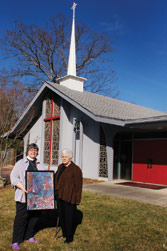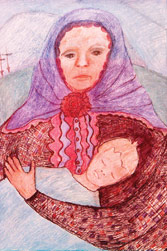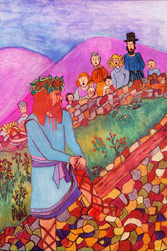When Penny Carscaddon took her first painting class in the late 1960s, painting the Stations of the Cross was the furthest thing from her mind. She was simply taking her young son to art classes hoping to improve his illegible hand-writing.

Like many women of her generation, Carscaddon (mother of N.C. rep Susan Fisher) did not begin to paint seriously until her children were grown. Her work and her life changed drastically in the early 1980s when she began to study with Janey McWhirter.
Her abstract work from that period is filled with movement and lyrical color. She rented a studio in the River District and was working regularly until she became ill. She kept the studio for a year, hoping to get back to her work, but her illness was unrelenting: She simply did not have the energy to pick up a brush.
For fifteen years, Carscaddon did not make art, but when her strength began to return, the urge to create returned with it. “I don’t know why I came to do the Stations,” Carscaddon says. “Not being Roman Catholic I was not that familiar with the concept of this mediation, but it spoke to me.”
With no studio, Carscaddon wanted to find materials that would be simple to use, but would have the rich vibrant color she loved. Crayola markers were readily available and mess-free: They were perfect! Carscaddon used the markers on canvas, and found that she could work at home without fear of spills or the odor of turpentine. “I just wanted to play with color again, and somehow do something worthwhile.”
Since the beginning of the Christian era, Jesus’ suffering on his way to the crucifixion has been a familiar and popular subject for artists. Referred to as The Stations of the Cross, these works have been installed on the walls of churches and cathedrals and in monastery gardens all over the world. Traditionally there are fourteen stations, beginning with Christ’s conviction and ending with his burial. Especially popular during the Lenten season, these creations are designed as a guide to meditation on the Christian’s atonement for Jesus’ sacrifice.
Twentieth century artists have continued the tradition. Matisse, for example, insisted that his only religion was “that of the love of the work to be created,” but considered his decoration of the Rose Chapel in Venice the pinnacle of his career.

Jeanne Finan, Rector of St John’s, is interested in incorporating visual art into the regular program at the church. “Not every parishioner is a verbal learner, some people are more visual,” she says. And, she quips: “Where else can an artist be assured that an audience will look at their painting for a full hour once a week?”
With her background in weaving and museum work, Finan says that the trend in many churches today is to look for spiritual enrichment in areas other than the weekly sermon. She believes that the arts are the obvious way to do this. “My favorite seminary class was on ecclesiastical art,” she says. And St. John’s, with its mid-century modern style offers an ideal venue for art.
The figures in Carscaddon’s works are expressionistic. She uses mosaic-like shapes to create the buildings, roadways and crowds in her backgrounds. These are frequently executed in the rich maroons and thalo greens and blues from her earlier oil paintings. These colors are used with great effect in station No. 7 where there are onion-shaped domes decorated with bright patterns. The overall feeling of movement in these new works also harks back to her 1980’s abstractions.

One of the strongest drawings shows the soldiers casting lots for Jesus’ garments. Carscaddon has captured the executioners “business as usual” attitude and casual approach to their work. The perspective in station eleven, which shows the crucifixion, is dizzying. The colors are muted, but the cross is presented diagonally and hands pop up from the cobblestone background holding big nails and odd hammers.
The March newsletter from St John’s offers this prayer “… today we give thanks for the way that Penelope’s work—its form, its color, its lines—open us to your mysterious Spirit in new ways.”
Carscaddon is now working with acrylic paint, and plans to go back to oils if she gets a studio. Who knows, perhaps those abstract paintings will come back.
[Connie Bostic is an Asheville based painter and writer.]
who: Candler artist Penny Carscaddon
what: Fourteen stations of the cross
where: St. John’s Episcopal Church, 290 Old Haw Creek Road.
when: Through April 11. Call 298-3553 for hours.



Please, please get your Webmaster to figure out how to have the little images “zoom” to a larger size.